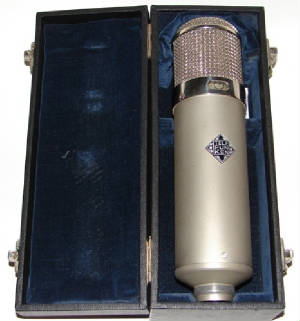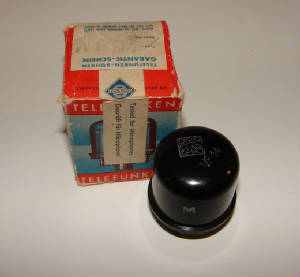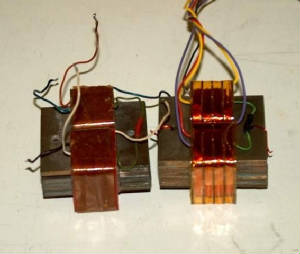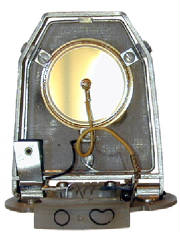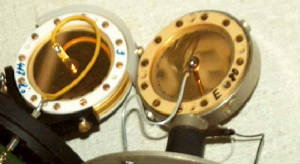The Great 47!
The Neumann U47 is probably “the microphone” that has had the largest impact on the recording industry and recording history. Before the war, the "Berliner Funkausstellung" (Berlin Radio Show) was the largest electronics trade show in the world. Suspended by the war, the show resumed in 1946 to little fanfare. The legendary Neumann U47 was introduced at the 1947 tradeshow and made a big splash based on its forward looking design and innovative technology standards.
Over 60 years after its introduction it’s still not 100% certain as to exactly how the U47 came to life. During the war, the original Neumann factory was bombed then relocated to Thueringen to restart production. After the war, the Allies traded the Thueringen region to the Soviets in exchange for West Berlin. The Soviets/East Germans seized all businesses in the territory and prevented any money from being exported out of the country. Telefunken, who had been the distributor for Neumann microphones before the war, helped Georg Neumann set up a new company in West Berlin after the war in 1945 and became 25% owners of the new Neumann Company as well as continuing the distribution for their products. The U47 was developed from roughly 1945 up to the Berliner Funkausstellung in 1947. It has been documented that Georg Neumann was invited by the French goverment and was mainly in Paris during the time of the U47's development. While Georg Neumann is given sole credit for the design and development of the U47, it’s unclear if he designed it before going to Paris and left it to Telefunken to develop or if he was part of the development while living in Paris.
It is quite likely that Telefunken had some hand in the development of the U47 given the fact that the VF14 tube was specifically developed and produced by Telefunken for use in the U47 and had no other previous commercial use. Telefunken began the development of steel cased tubes around 1936 and the first working versions came off the production line around 1938. Before 1947, there is no mention of the VF14 tube in any design documents or any catalogs by Telefunken. The original design documents for the VF14 have no dates on them, but it does specifically state that the VF14 was designed for use in microphones. The very first microphone that it was used in was the U47 and later in the U48 as well as the MM type of measuring mics. Telefunken records show that they continued to produce the VF14 tubes up until 1958.
The first U47’s were built using the Neumann M7 capsule. AEG was one of the original licensees of the 394 condenser capsule that had been used in Western Electric’s 47a microphone. Neumann was a young engineer who at one time worked for AEG. The M7 was specifically designed and developed to get around the patents held by Western Electric on condenser capsules. It is first shown in a catalog in 1932. The M7 used a much thinner diaphragm than the 394 (12 microns versus 25 microns) and instead of the solid aluminum foil used in the 394, the first M7 used PVC with a gold dusted layer that was later changed to a sputtered “disc” on the PVC.
The other major difference was that the M7 featured a diaphragm on both sides of the plate enabling the capsule to pick up sound 360 degrees around the mic. Thanks to the dual diaphragm of the M7, the U47 was the first microphone to feature a switchable polarity pattern (cardioid and omni) on the microphone as opposed to changing the capsule assembly.
Another interesting feature to the U47 is the use of the BV8 transformer. The transformer was custom developed by the NWDR (North West German Radio) for audio applications. Up to this point, transformers were designed for electrical efficiency and not for sound. The BV8 had a number of unique elements to its construction. It was the first transformer to utilize four chamber bobbins and they chose to use U-I lamination over E-I lamination giving the transformer a symmetrical square footprint. This design creates about 40% of material loss when stamped out but provides the least amount of distortion and the highest frequency response compared to the standard shape during the time. The BV8 was being used as a transformer in other audio applications (RE44 input) when the decision was made to use it in the U47.
With its high quality components, ground breaking design, good looks and the distribution clout of the historic
Telefunken Company, the U47 quickly became the microphone to use in nearly every recording and broadcast application. Perhaps the most surprising aspect of this mic is the simplicity of its design. It is amazing how good it sounds with such a straightforward and uncluttered design. Its only drawback was the price that it commanded- around $400 back then or about $3,600 in today’s currency! At that time, the U47 was priced about three times higher than the price of the best ribbon mic on the market. But the price didn’t stop the proliferation of this mic into all of the best recording studios in the 1950’s. Neumann stopped production in the early 1960’s but with a modest supply of VF14 tubes Neumann occasionally created special versions of the U47 for people in the industry. For example, Bryan Adams received a pair of specially built U47’s from Neumann as late as the early 90s.
For recording engineers, the U47 is the most recognizable mic, and even the average person will recognize it due to the fact that so many famous artists have been pictured with the mic from its inception to today. The U47 can be found in virtually every book on recording, biography of singers, documentaries as well as videos, and even immortalized in song lyrics. It simply is one of the vintage mics that everyone wants to have. If imitation is truly the sincerest form of flattery than the U47 is admired by folks around the globe. There are more clones and derivatives made based on the U47 design than any other mic in recording history!
So, is it truly special or is it a status symbol? The answer is both. To a skilled engineer well versed in placing mics and building the proper gain structure, there definitely is some magic that happens with this mic. The combination of capsule, tube, amplifier circuit and transformer creates harmonic overtones that are pleasing to the human ear. This effect provides warmth, richness and thickens the sound of the source being recorded. The U47 shines on close mic'd guitar cabs and close-up male vocals. For example, during the height of his greatest 1950's and 1960's recordings, Frank Sinatra recorded almost exclusively on Telefunken branded mics.
But the U47 was limited in production to a best estimate of 5000-6000 units. While that sounds like a lot, when you consider the number of recording studios around the world (all of which would like a stereo pair…) and the number of home studios that are in use, there aren’t enough to go around to everyone who wants one. As a result, a lot of people see the U47 as the ultimate status symbol. If you have one, you’re viewed as a serious, professional (and successful) studio that can produce quality recordings. Additionally, as engineers, producers and artists specifically request the Neumann U47, it has become one of the “must have” microphones to secure named artists to work at one’s studio.
In the end, microphones are like paint brushes. There is no one brush that can be used for every style or aspect of painting and the same is true with microphones. However, the U47 is a “brush” that can be used for nearly everything and it will always deliver full, rich and vibrant colors of sound on a recording.
Also Read:

